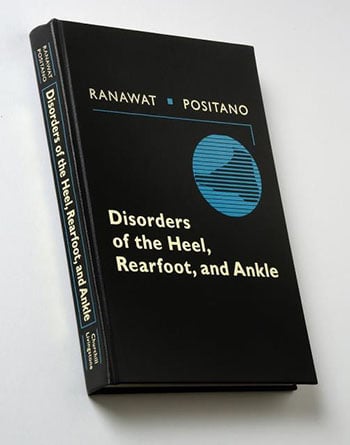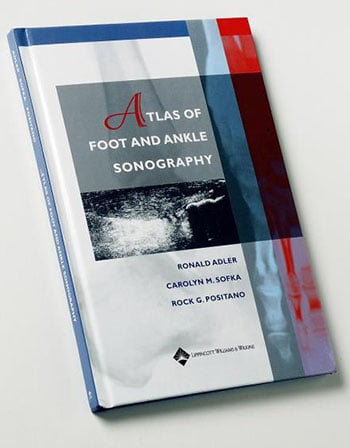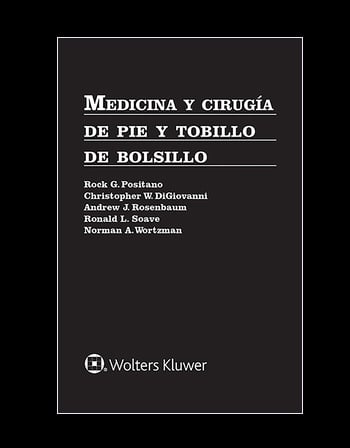About Dr. Positano
Dr. Rock G. Positano has been on staff at HSS since 1991 and is nationally known for his non-surgical approach for the treatment of foot disorders. He serves in the capacity of Founder and Director of the Non-surgical Foot and Ankle Service and the Heel Pain Center at HSS. Dr. Positano was featured on the front page of the New York Times in an article concerning the dangers of cosmetic foot surgery. He has authored and edited numerous peer reviewed articles and has served as the editor of 12 medical textbooks ranging from foot and ankle orthopedics, heel disorders, to sports medicine. His thesis on Foot Health was approved 'With Honors' and 'With Distinction' by the faculty of the Yale School of Medicine.
Dr. Positano specializes in musculoskeletal podiatry, the non-surgical diagnosis and treatment of muscle, tendon, ligament, and bone disorders of the foot and ankle using physical therapy protocols/modalities and prescription foot orthoses. In addition, musculoskeletal podiatry involves evaluating and treating biomechanical relationships of how the foot affects knee, hip, and back function and pathology using prescription foot orthoses.
Spanish: Español (pdf)
Italian: Italiano (pdf)
French: Français (pdf)
German: Deutsch (pdf)
Portuguese: Português (pdf)
Turkish: Türkçe (pdf)
Greek (pdf)
Japanese (pdf)
Chinese (pdf)
Arabic (pdf)
Korean (pdf)
Russian (pdf)
Hebrew (pdf)
Most common conditions treated in the field of musculoskeletal podiatry includes:
- Heel/rearfoot pain
- Plantar fasciitis/arch pain
- Forefoot pain
- Heel spur syndrome
- Achilles tendonitis/Haglund’s Deformity/Retrocalcaneal bursitis
- Ankle sprains
- Metatarsal problems
- Neuromas
- Bunion deformity/arthritis 1st MPJ or 1st MPJ dysfunction
- Shin splint syndrome/medial tibial stress syndrome
- Simple, closed, non-displaced fractures
- Pes planus (flat foot)
- Cavus foot
- Stress fractures
- Sesamoid injuries
- Peroneal, anterior, and posterior tibial tendonitis/tendinosis
- Generalized foot pain and discomfort
- Cycling and ski boot injuries
- Midtarsal/Ankle joint osteoarthritis
- Orthotic prescription and fabrication
- Podiatric biomechanical correction of knee, hip, and back disorders
- Acute gout
- Sports injury prevention
- Children’s foot disorders - metatarsus adductus (in toe), flat foot, etc
- Type 2 (not Type 1) diabetic foot care and prevention (excluding ulcers or open wounds)
As the founder and director of the Non-surgical Foot and Ankle Service, he is dedicated to evaluating the majority of foot and ankle problems that often can be treated successfully without surgery. This service is the very first in the greater New York area located at a major orthopedic teaching hospital dedicated to orthopedic/musculoskeletal care and research in developing non-surgical treatments for foot and ankle ailments as well as optimizing the relationship between foot function and the effects on the knee, hip and lower back disorders.
The Service is nationally renowned for its expertise in the design and fabrication of prescription foot orthotics used to treat many orthopedic foot and ankle problems. In addition, foot orthotics are prescribed to treat biomechanically related problems involving the knee, hip, and lower back, as these conditions are often responsive to the stability and improved mechanics that these devices provide.
The Service treats non-complicated fractures of the foot/ankle and has a direct affiliation and access to the Sports Medicine Institute, the Orthopedic Trauma Service (OTS) at HSS and NewYork-Presbyterian Hospital/Weill Cornell Medical Center, the Limb Lengthening and Deformity Service, and the Orthopedic Service of the Department of Surgery at MSKCC.
The Non-surgical Foot and Ankle Service provides access to state of the art diagnostic testing that includes diagnostic ultrasound, computerized motion and gait analysis, bone densitometry, MRI, CAT scan, X-rays, and bone scans.
Special Expertise
Custom Orthotics
Heel Pain
Heel Pain, Very Common and Debilitating, Often Misdiagnosed as Plantar Fasciitis Has Become a Rampant Musculoskeletal Public Health Issue During the Post-Pandemic
Heel pain is one of the most common ailments that is found in the active population. Unfortunately a painful heel can be severely debilitating if not properly diagnosed and treated. It may not be life threatening but it is certainly quality of life threatening and affects a person’s ability to walk, stand, exercise and participate in social activities.
Heel pain is the great impersonator and can signify a wide range of medical problems from a common musculoskeletal problem known as plantar fascia to a cancer metastasis in the heel bone from breast, prostate, lung and other areas. There is no such thing as simple heel pain and this complaint should never be trivialized and relegated to an internet search. All too often we will evaluate a patient who has had heel pain for over a year only to find that there is a more serious underlying problem such as a tear in the plantar fascia.
Interestingly, heel pain is one of the most misdiagnosed musculoskeletal conditions. Physicians often misdiagnose heel pain as plantar fasciitis based on the clinical exam alone or in conjunction with an MRI, without performing a diagnostic ultrasound to rule out other possible causes. The wrong diagnosis can not only prolong a patient’s suffering and decrease quality of life, but can do more harm than good if the incorrect treatment is prescribed. For example, it can lead to unnecessary surgery. Even worse, it can trigger serious systemic health issues such as cardiovascular disease, Type 2 diabetes, obesity, osteoporosis, and depression, due to inactivity and lifestyle changes caused by pain.
Many clinicians as well as the public often conclude that MRI should be the diagnostic test of choice when looking at a heel injury, however, technical advances and higher-frequency transducers have made diagnostic ultrasound technology more desirable than MRI in the diagnosis of foot pain, and it’s much less costly and does not require an often claustrophobic environment associated with the MRI tube.
We published a 2015 study conducted by our Non-surgical Foot and Ankle Service and Heel Pain Center at Hospital for Special Surgery (HSS) and found that a safe and painless diagnostic ultrasound test can pinpoint the exact cause of heel pain and ensure the most effective and safe treatment.
Our findings led us to conclude that diagnostic ultrasound can effectively and safely identify the true cause of heel pain. The high prevalence of plantar fibromas and plantar fascial tears cannot be determined by clinical examination alone, and, therefore, ultrasound evaluation should be performed to confirm the diagnosis. This specialized diagnostic test could spare many people an incorrect diagnosis, potentially harmful treatment and needless suffering.
The pandemic has produced an unprecedented increase in foot problems, particularly in the heel.
Foot pain isn’t just a unidimensional issue. Our experience both anecdotally as well as scientific research has revealed that a painful foot will quite often cause pain and dysfunction elsewhere in the body especially the knee, hip and lower back. What starts in the foot most likely will travel up the motion chain to these other body parts.
Foot, Ankle and Lower Extremity Joint Preservation
Due to the tremendous forces sustained by the foot and ankle on a daily basis this non-surgical service developed specific therapeutic and preventive protocols that help to retard and prevent the rapid development of osteoarthritis as well as degeneration and damage to the numerous muscles, tendons and ligaments in the foot and ankle.
Treatments that include therapeutic ultrasound, phonophoresis, and EPAT combined with a well- designed and prescribed foot orthoses used to stabilize and protect the foot has proven to be both beneficial, therapeutic and preventive in nature.
This benefit also extends to the knee, hip and lower back as improved foot and ankle function and shock absorbing ability is directly connected to decreased force and malalignment of these other parts of the lower extremity.
Pregnancy and Foot and Ankle Care
It has been well established that in addition to soft tissue and hormonal changes, the lower extremity and especially the foot and ankle, undergoes various structural and functional changes throughout the course of pregnancy. These lower extremity and foot changes can continue into, or even advance beyond, the postpartum period. Each trimester of pregnancy carries certain challenges that the lower extremity, and especially the foot and ankle, have to overcome for the patient to maximize their quality of life.
As the fetus grows in both size and weight, there is a gradual shift in the expectant patient’s center of gravity due to increased volume within the gravid uterus. This shift, along with increased gravitational pull of increased BMI, in turn creates a stronger fulcrum, or bending/pivot force, on the lower extremity which increases demand on the lower extremity and foot, forcing it to compensate in order to maintain the proper musculoskeletal balance needed for metabolically efficient walking to occur.
Increased ‘turning in’ (or pronation) of the foot with consequent turning in (or internal rotation) of the lower leg, due in part to both the dimensional and volumetric changes of the growing fetus, increases stresses throughout the entire length of the foot and in particular the arch and heel of the foot, especially during walking or weight bearing activities.
To add, whatever foot and ankle pathology or morphology that may have existed before the onset of pregnancy (whether properly addressed or not) risks being further exacerbated, or even uncovered, by the various anatomic and physiologic changes brought on by pregnancy.
Conditions such as heel pain, ankle pain, bunion pain, lower leg pain, knee, hip and lower back discomfort are very common during and after the pregnancy. These conditions left untreated can cause major discomfort in the expectant mother.
Read more: Foot Problems During and After Pregnancy
Type II Pre-Diabetes and Diabetes Musculoskeletal System Foot and Ankle Care
Diabetes Mellitus is the most common metabolic disease in the world with a global prevalence reported up to ~451 million people and rising and a major source of our global disease burden. Type 2 Diabetes (DM2) accounts for >90% of all cases of diabetes types and typically affects active adults of all ages.
One of the heralding, and perhaps underdiagnosed, features of DM2 is its effect on the musculoskeletal system such as the foot, ankle, knee, shoulder, hip and spine (lower back/upper spine) in particular.
The excess glucose circulating around the body over an extended period of time will start to negatively affect the soft tissue structures supporting our joints contributing, but not exclusive, to common pathologies such as: 1) tendonitis 2) osteoporosis 3) osteoarthritis 4) muscle and foot cramping 5) limited joint mobility syndrome 6) peripheral neuropathy 7) circulatory compromise affecting arteries, veins and nerves.
If left untreated or mismanaged, these issues singularly, or in concert, will disrupt a person’s quality of life because it will affect their ability to move as they please and participate in exercise and walking activity.
This can prove troubling especially if the person leads a motivated and active lifestyle, and can further precipitate the negative cascade of increasing the risk of developing more serious chronic systemic diseases especially involving the cardiovascular system and maintenance of weight control and DM2 related monitoring levels of insulin/glucose indicators such HbA1c, insulin resistance, Body Mass Index (BMI) and other metabolic factors.
Musculoskeletal issues affect the DM-2 patient’s ability to exercise which is imperative to improve cardiovascular function, maintain blood pressure and bone density, anxiety and stress reduction just to name a few.
DM2 patients have specific needs and prevention strategies when dealing with musculoskeletal issues especially if the patient would wish to begin an exercise program or maintain a current one to best avoid injury.
This is the first practice of this kind that directly addresses the musculoskeletal needs of DM2 patients and has the participation of multiple health care practitioners, a specially trained NP (Nurse Practitioner), MD (Medical Doctor), DPM (Doctor of Podiatric Medicine), DC (Doctor of Chiropractic) and a Motion Gait Analysis facility that provides the patient with the ultimate comprehensive musculoskeletal care team approach.
Patient ratings for Dr. Positano
Insurance
If your insurance is not listed, please call our office if you have questions regarding your insurance coverage. If you have out-of-network benefits, then your insurance may reimburse you for a portion of your office visit.
Credentials
Appointments
- Director and Founder, Heel Pain Center
- Co-Director and Founder, Non-surgical Foot and Ankle Service, Department of Orthopaedics, Hospital for Special Surgery
- Director, The Foot Center / Sports Medicine, Orthopedic Trauma Service, NewYork-Presbyterian/Weill Cornell Medical College
- Clinical Assistant Professor, Weill Cornell Medical College
- Faculty, Department of Cardiothoracic Surgery, Weill Cornell Medicine
- Faculty, Department of Medicine/Endocrinology, Weill Cornell Medicine
- Faculty, Department of Obstetrics and Gynecology, Weill Cornell Medicine
- Professor and Chairman, Department of Academic Orthopedic Surgery, New York College of Podiatric Medicine / Foot Center of New York
- Foot and Ankle Consultant, Orthopedic Service of the Department of Surgery at Memorial Sloan Kettering (MSKCC)
- Deputy Chairman of the Board, New York College of Podiatric Medicine / Foot Center of New York
- Associate Clinical Professor of Epidemiology, Department of Chronic Disease Epidemiology (Foot, Ankle, Lower Extremity), Yale School of Medicine/Yale School of Public Health
Professional Leadership Positions
Yale School of Public Health Leadership Council
Yale School of Management Council of Global Advisors
Affiliations
Sports Medicine Institute
Orthopedic Trauma Service
HSS Spine
The New York Mets, Foot and Ankle Consultant
The New York Giants, Foot and Ankle Consultant
Limb Lengthening and Complex Reconstruction Service
The Associated Press, Sports Medicine Consultant (Foot and Ankle)
CBS, NBC, ABC, CNN, FOX, PAX, Television Foot Consultant
New York Daily News, Weekly Sports Medicine Columnist
Office of the Chief Medical Examiner, City of New York (Forensic Identification), Consultant
Fenerbache Professional Soccer Club, Istanbul, Turkey
Health Contributing Writer, US News & World Report
Awards
Recipient of a Stavros Niarchos Foundation grant
Education
DPM, Doctor of Podiatric Medicine, New York College of Podiatric Medicine, New York
DSc, Doctor of Science, New York College of Podiatric Medicine, New York
MPH, Master of Public Health, Yale School of Medicine, New Haven, Connecticut
MSc, Master of Science, NYU School of Medicine,Institute of Environmental Medicine, New York
BA, NYU College of Arts and Science, New York
Fellowships
Foot Clinics of New York, New York
Yale School of Medicine
NYU Medical Center- Institute of Environmental Medicine, New York
State Licensure
New York, New Jersey, Rhode Island
Languages
EnglishFor My Patients
Publications by Dr. Positano
Patient Education
Editorial Appointments
Weekly Sports Medicine Columnist, New York Daily News
Health Contributing Writer, US News & World Report
Selected Journal Articles
Selected Books/Chapters

Disorders of the Heel, Rearfoot, and Ankle

Foot and Ankle Sports Medicine

Atlas of Foot and Ankle Sonography

Medical Clinics of North America - Environmental Medicine

Clinics in Podiatric Medicine and Surgery - Applied Biomechanics

Clinics in Podiatric Medicine and Surgery - Occupational Medicine

Systemic Disease Manifestations in the Foot, Ankle, and Lower Extremity

Medicina y Cirugía de Pie y Tobillo de Bolsillo

Multiple Sclerosis for the Non-Neurologist

Foot and Ankle Pain Management

A Cena con Joe DiMaggio
Research
- Development of non-surgical treatment and prevention programs for foot and ankle problems- Hospital for Special Surgery; Yale School of Public Health (Chronic Disease Epidemiology)
- Framingham Foot Study that studies the incidence and development of foot and ankle disorders in the general population and the effects on knee, hip and back disorders Hospital for Special Surgery; Yale School of Public Health (Chronic Disease Epidemiology)
- Development of new prescription foot orthoses prototypes for the non-surgical treatment of foot and ankle problems- Hospital for Special Surgery
- Development of prescription foot orthoses prototypes for the treatment of lower extremity musculoskeletal problems such as biomechanical disorders of the back, knee, hip, and lower leg- Hospital for Special Surgery
- Creation of joint preservation strategies for the foot, ankle, knee, hip, and back- Hospital for Special Surgery; Yale School of Public Health (Chronic Disease Epidemiology)
- Prevention of both foot injury and arthritis progression in the foot and ankle- Hospital for Special Surgery; Yale School of Public Health (Chronic Disease Epidemiology)
- Establishment of public health protocols to preempt the development of foot and ankle ailments- Hospital for Special Surgery; Yale School of Public Health (Chronic Disease Epidemiology)
- Development of sport-specific orthotic devices (tennis, golf, sneakers, etc.) to increase performance and decrease injury- Hospital for Special Surgery
- Systemic disease manifestations in the foot, ankle and lower extremity- Hospital for Special Surgery; Yale School of Public Health (Chronic Disease Epidemiology)
- Effects of Type II Diabetes on the foot and ankle musculoskeletal system- Weill Cornell Medicine/ Hospital for Special Surgery/ Department of Medicine/Division of Endocrinology
- Foot and ankle problems during pregnancy- Weill Cornell Medicine/ Hospital for Special Surgery/ Department of Obstetrics and Gynecology
- Foot and ankle problems associated with chemotherapy and oncology- Hospital for Special Surgery/ Memorial Sloan- Kettering Cancer Center/ Department of Orthopedic Surgery/Foot and Ankle Division
- Foot and ankle problems associated with MS and other neurological diseases- Weill Cornell Medicine/Hospital for Special Surgery/Department of Medicine
- Foot and Ankle manifestations in the presence of cardiovascular disease- Weill Cornell Medicine/Hospital for Special Surgery/Department of Cardiothoracic Surgery
Clinical Trials / Research Studies
Industry Relationships
HSS has a long history of supporting appropriate relationships with industry because they advance HSS's mission to provide the highest quality patient care, improve patient mobility, and enhance the quality of life for all, and to advance the science of orthopedic surgery, rheumatology, and their related disciplines through research and education.
Below are the healthcare industry relationships reported by Dr. Positano as of March 24, 2023.
- Orthobond Corporation - Ownership Interest
HSS and its physicians make this information available to patients and the public, thus creating a transparent environment for those who are interested in this information. Further, the HSS Conflicts of Interest and Commitment Policy prohibits physicians from collecting royalties on products they develop that are used on patients at HSS. Patients should feel free to ask their HSS physicians questions about these relationships.



